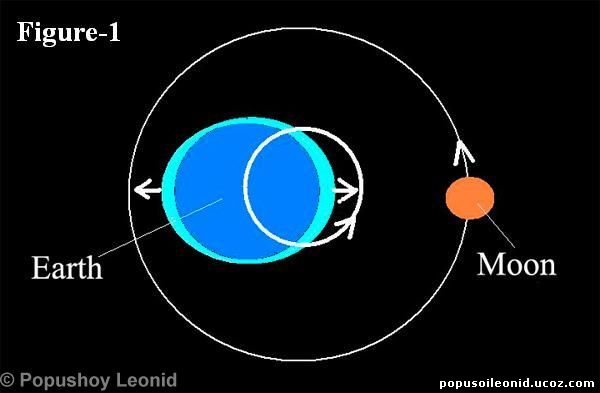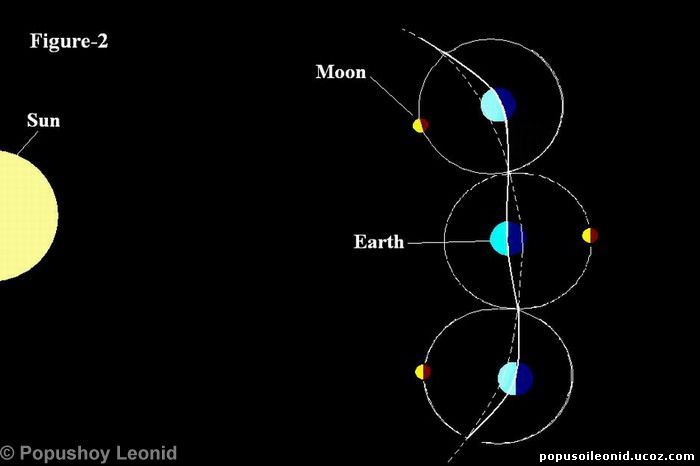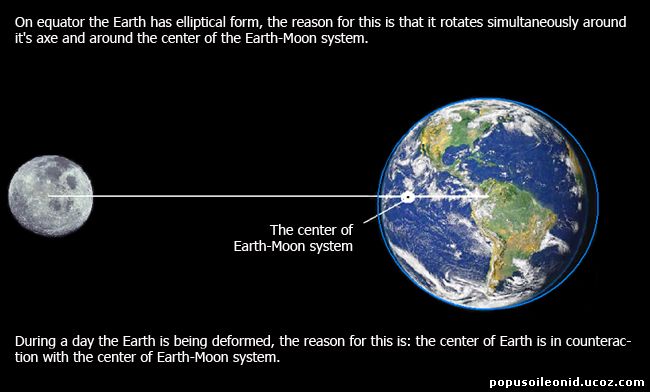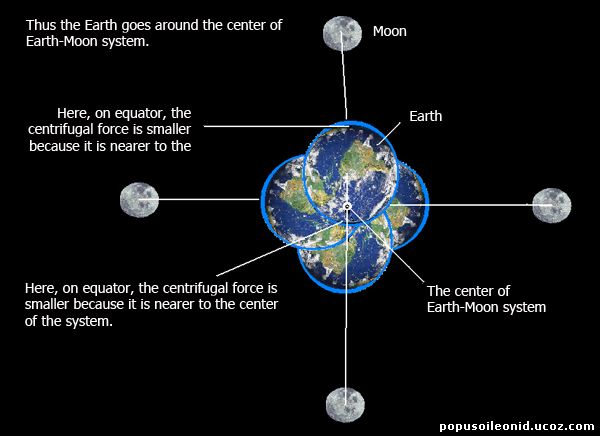|
Thursday, 2024 Apr 25, 12:52 Welcome! Guest | Register | Log in |
|||||||||||
Сенсационное открытие | |||||||||||
|
Chapter Three. How does the Earth’s motion influence the weather and tides?The weather for tomorrow - what can be more actual to each of us. We can watch the news without emphases, but as soon as the weather forecast begins we throw our deals and listen attentively to each word of the speaker, trying to remember what temperature is expected, which will be the wind velocity, and if the precipitations are expected. The users of the weather forecast are milliards of people of so different professions as agronomists, chauffeur, geologists, pilots, sailors, builders, and mountaineers. The weather forecasts are a part of life either of the citizens or the villagers. We got accustomed to live by science. But…the long-term forecasts of nowadays come true for 55-60 percent, that is to say that four of each ten forecasts turn out to be wrong. The theoretical limit of predictability of weather constitutes 7-10 days, not more. Some meteorologists affirm that the weather could be predicted absolutely right only for a day in a radius to 200 km. The scientists consider that the faultless forecast will be still beyond the science for many years, because the absolute exactly forecast, even for a day onward, needs collecting and analyzing the data from each square kilometer of the terrestrial surface. Besides, very often the forecasts turn out to be inexact, because the weathermen haven’t taken all the factors into account, which cause the changes of weather. One of such factors that haven’t been taken into consideration is that that it is necessary to know such a regularity of weather changing as its dependence on particularities of Earth’s motion along its orbit around Sun. It is made an opening, which proves that during a month the Earth’s velocity of motion along its orbit changes twice: it now increases, now decreases that, in turn, cause the forming of cyclones. The atmospheric pressure varies, strong flows of cold or warm air are being formed, often the cold cyclone unexpectedly breaks the warm weather, in the change of a calm weather comes a strong wind, which, in turn, brings a cold snap and a strong frost. As a matter of fact, nothing unexpected happens. This is a cause of that that the Earth’s velocity of motion along orbit around the Sun is uneven, in the first case it increases, in the second - it decreases, and so it is repeating each month. It is possible to calculate exactly this phenomenon. When the Earth’s velocity on orbit around the Sun increases or decreases then are forming the cyclones and anticyclones. What new horizons this regularity opens in science, and what it is possible to explain by it? Let’s examine our theory by means of the pictures and schemes. In the picture-1 it is represented the orbit of Moon and the small orbit of Earth. During a month the Moon make a full rotation around the Earth, and the Earth makes a rotation on its small orbit. Between Moon and Earth exists an attractive power, under the action of which, on the area between Earth and Moon are happening tides, they happen on the opposite side too, but already by reason of the centrifugal power. The centrifugal powers appear, because the Earth revolves around a centre of balance, which is situated between Earth and Moon, concretely in the centre of the small orbit (see figure-1). The sprain of the Earth’s surface happens under the action of two powers: on the one hand influences the attraction of Moon, on the other hand- the centrifugal power. This factor is a proof of the small orbit’s existence.  Because of that, that the Earth has a small orbit, its motion around the Sun happens not along a straight orbit, but along a wave-like trajectory (see figure-2).  There is another factor, which plays an important role in the forming of tides, as follows: the changing of the velocity of Earth and Moon twice a month. During a month the kinetic energy (velocity) of Earth permanently changes, hereupon the intensity of tides can be various. During a month, when the kinetic energy increases, and respectively the height of tides increases (we remind that the velocity during the first half of month increases by 9400 km and the next half of month decreases by 9400 km). When the Earth has the greatest velocity, then the lowest tides happen. It is known that the height of tides changes during a month, this is the proof of that that the velocity of Earth changes during a month. Besides the lunar cycle, we can say about an annual cycle: in winter the velocity of Earth is greater than in summer. In winter have being observed the most high tides, this proves that in this time of the year the Earth has the greatest velocity. Why does the velocity of Earth influence the forming of cyclones? We cite an instance with an automobile, which when gathers momentum, when slows down. This allows us to notice some analogy with the changing of Earth’s velocity. Imagine: driver drives a car with a medium velocity of 60 km/h, if push the gas treadle, then due to the velocity increasing the driver under the inertia influence is rejected back, when breaking, the velocity decreases, and the driver is attracted onward. Approximately the same happens when Earth’s moving along its orbit during a month. When the Earth’s velocity increases, the air and water streams come off the solid mass (the crust), forming a concourse of air mass and high pressure. And when the Earth’s velocity decreases, happens the inverse, herewith the air streams are rushing onward. When the velocity of Earth is increasing, the air streams shape up to an ellipse, the cyclones stretch from the North and South poles to the equator. The Earth’s rotation around its axis during a day makes the cyclones to move. A more calm weather is being when the unchangeable Earth’s velocity. On the basis of the aforesaid we can affirm that during every month the kinetic energy (velocity) of Earth permanently changes, according to this, the seasonal weather changing happen. The power of cyclones depends on the kinetic energy of Earth (the velocity of its motion along orbit), the greater is the velocity the more active are the cyclones. The three new regularities give possibility to find the reason of volcano eruptions, forming of magnetic field on Earth, forming of tides and forming of air cyclones on Earth’s surface. The scientific world can’t give an answer, why do volcanoes erupt, where from does appear energy, what is the reason of forming of Earth’s magnetic field etc. I am trying to give the answer to these questions. All of these natural phenomenons (volcano eruptions, magnetic fields, tides, and air cyclones) are interrelated. I am suggesting the discovered by me regularities. The first regularity: Earth’s mass is 81 times bigger than Moon’s mass. We know the average distance between Moon and Earth, which is 384000 km. This distance is the radius of Moon’s orbit. We divide radius 384000 to 81 – the difference of masses and we get the radius of the small Earth’s orbit, and this is equal to 4740 km. In accordance with the Law of conservation of linear momentum, Earth and Moon form the system Earth-Moon. The center of the system Earth-Moon is found on a distance of 4740 km from the center of the Earth. The system Earth-Moon is rotating around this center. In reference to Sun, during a month the Earth deviates from the big orbit on 9400 km. The second regularity: during a month the Moon approaches to and moves away from Earth on a distance of 42592 km. According to the Law of conservation of linear momentum, not only the Moon approaches to Earth, but the Earth also approaches to Moon. We divide the distance 42592 km on difference of masses 81, and this is equal to 525,8 km. During a month the Earth approaches to and moves away from center of the system Earth-Moon on a distance of 525,8km. The third regularity: Because Earth during a day rotates around its own axis, the centrifugal force is forming on equator. The radius of Earth’s equator is 6371,0 km. The center of the system Earth-Moon is found at 4700 km from the center of the Earth. This means that one side of equator is closer to the center of the system Earth-Moon on 1670 km. The other side of equator is farther on a distance of (4700 + 6371,0 km) = 11071 km. The difference is 9400 km. During 27,7 days the Earth makes a rotation around the center of the system Earth-Moon. The distance of deviation passed during a month, 9400 km divided to 27,7 days = 339,3 km. The distance of deviation passed during a day, 339,3 km divided to 24 h = 14,13 km. The distance of deviation passed during an hour, 14,13 km divided to 60 minutes = 235 meters. The distance of deviation passed during a minute, 235 meters divided to 60 seconds = 3,91 meters per second. The next regularity is demonstrated: on equator the Earth has different indexes of centrifugal force, which change in accordance with the daily rotation of Earth around its own axis. The difference between the velocity on equator by the Moon and the one on the opposite side is 3,91 meters per second. The velocity on Earth’s equator by the Moon is less 3,91 meters per second than by the opposite side. On Earth’s surface the masses of air and water move with an average velocity of 3,91m/s. It’s necessary to consider other factors too, in the winter time the Earth approaches on 5millions km to the Sun, and in the summer time moves away on 5 millions km from it. During a month the Earth deviates from the orbit on 9400 km. the Earth approaches on 525 km to Moon. The system Earth-planets-Sun influences the system Earth-Sun. The system Earth-Moon is permanently being under the influence of the system Earth-planets-Sun. For example: if the Earth wasn’t rotating around its own axis, its center wouldn’t depend of these centers of the system. Because the Earth rotates around its own axis, its center is being in a counteraction with systems Earth-planets-Sun and Earth-Moon. This permanent counteraction between systems influences the forming of each planet’s and Sun’s energy. Each system searches its own center of balance, and at the same time it has to depend on the common system.  Tides prove that the Earth deformates.  In conclusion of third chapter there are three regularities: 1. The factor that tides simultaneously happen on two sides of Earth is the proof of the existence of the small orbit of Earth. 2. The height of tides during a month increases and decreases and this is the result and the proof of that that Earth’s velocity along its orbit changes twice a month. 3. The intensity of cyclones depends on the changing of Earth’s motion velocity along the orbit.
|
||||||||||
Copyright MyCorp © 2024 | |||||||||||